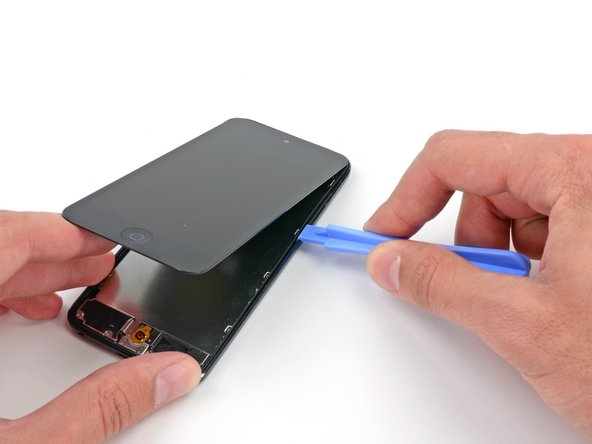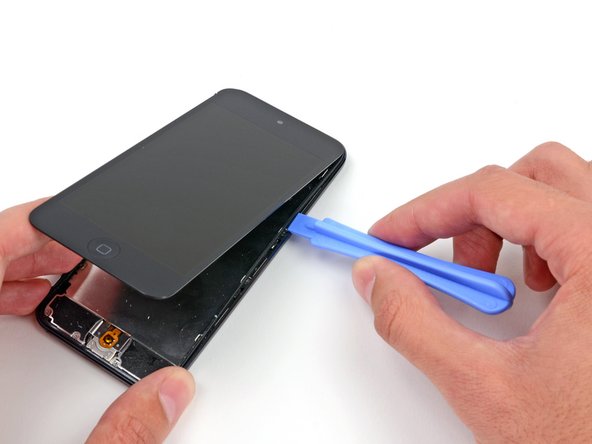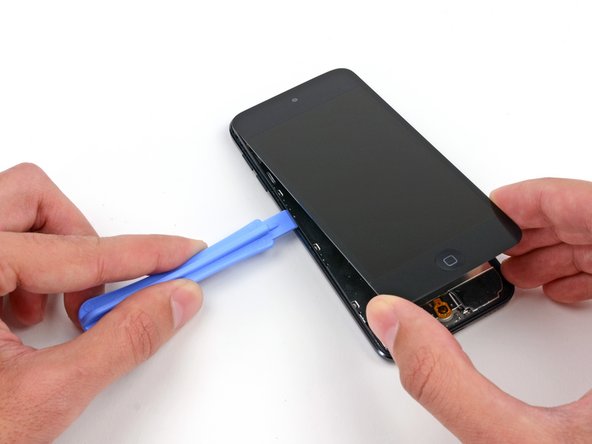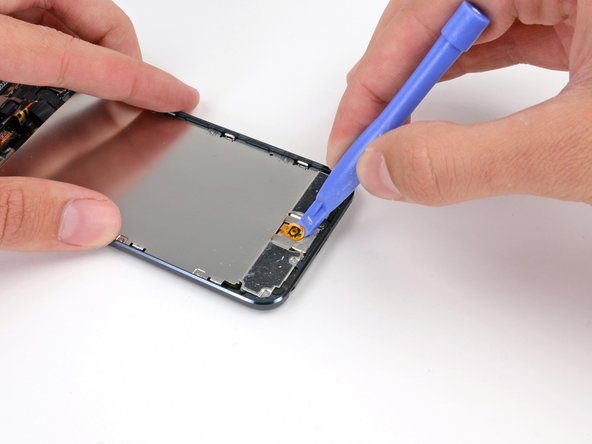How To Repair Ipod Touch 6 Screen
Introduction
Cracked your screen? Apply this guide to supersede the display assembly from your iPod Impact.
Note that the pictures shown in this guide are the 5th generation iPod touch. The sixth generation is generally the same merely with some superficial differences.
-
-
If your brandish drinking glass is croaky, go on further breakage contained and preclude bodily impairment during your repair by taping the drinking glass.
-
Lay overlapping strips of clear packing record over the iPod's display until the whole confront is covered.
-
-
-
Apply a hairdryer or prepare an iOpener and use it to the lower edge of the iPod for well-nigh a infinitesimal in guild to soften upwards the adhesive underneath.
-
The bottom of the screen (near the abode button) is held in place with potent adhesive.
-
As yous start prying the screen off in the next stages, you may need to apply more than heat to keep the glue warm and flexible.
-
-
-
Middle the suction loving cup on the lower department of the glass, with its edge centered over the abode button.
-
Press in firmly and make sure the cup has a strong seal.
-
-
-
Hold the iPod firmly against a table or bench.
-
Lift the suction cup up and back toward the pinnacle of the iPod. Be patient, and pull with firm, constant forcefulness until the agglutinative breaks and the display comes up from the rear case.
-
It may exist necessary to employ a estrus gun to soften the agglutinative (especially in cooler climates). If yous can pry the screen apart, and the agglutinative is still sticking and pulling autonomously like cheese topping on a pizza, you can slide a thin razor blade in and gently cut the adhesive.
-
-
-
Starting at the elevation correct of the device, insert a plastic opening tool into the gap betwixt the plastic frame and the aluminum rear case.
-
Slide the tool down this crack, loosening the frame from the case.
-
-
-
Insert the plastic opening tool between the frame and the rear case behind the first clip.
-
Rock the tool sideways, to spread the gap backside the clip and divide information technology from the rear example.
-
This may non free the prune initially, only repeating the procedure for each prune will brainstorm to loosen the piece.
-
-
-
Repeat the process with the next 2 clips on this side.
-
-
-
Moving on to the left side of the device, insert a plastic opening tool into the gap between the plastic frame and the aluminum rear case about the top.
-
Slide the tool downwards this crack, loosening the frame from the case.
-
-
-
Insert the plastic opening tool between the frame and the rear case behind the first clip on the left side.
-
Rock the tool sideways, to spread the gap behind the clip and split it from the rear case.
-
-
-
Echo the procedure with the next two clips on this side.
-
Insert the plastic opening tool betwixt the plastic frame and aluminum rear case behind the second clip.
-
Rock the tool sideways, loosening the clip from the case.
-
-
-
Using the same procedure, loosen the last clip securing the plastic frame to the rear instance.
-
-
-
Insert the plastic opening tool between the brandish assembly and the rear case near the peak of the iPod.
-
Slightly twist the opening tool to pry the front panel upward from the rear case.
-
Divide the display assembly from the iPod.
-
-
-
If your iPod has a black abode push button assembly rather than the orangish one shown here, you can skip this pace. The button is not attached to the LCD plate and does not demand to exist removed to complete the repair.
-
Use a plastic opening tool to pry the abode push button switch up from the LCD plate.
-
It may be necessary to use a heat gun or pilus dryer to soften the adhesive on the dorsum of the dwelling button. Always employ a depression heat setting.
-
-
-
Remove the following screws securing the LCD plate to the rear case:
-
Two 1.2 mm #000 Phillips screws
-
9 1.six mm #000 Phillips screws
-
One 2.3 mm #000 Phillips screw
-
-
-
Elevator upwards and remove the LCD plate from the iPod.
-
-
-
Remove three 1.6 mm #000 Phillips screws securing the logic lath to the rear instance.
-
-
-
In that location are 2 strips of adhesive keeping the battery in place.
-
Plow the iPod over and heat the BACK of the aluminium iPod instance. Do not heat the bombardment.
-
The aluminium example does not take to be hot; you should e'er be able to touch heated parts with your fingers at all times without information technology being uncomfortable.
-
-
-
Insert a plastic opening tool into the top correct notch and gently pry upwardly on the battery.
-
-
-
Proceed with the lower correct notch. Insert the plastic opening tool into the notch, and gently pry upwards on the side of the bombardment.
-
-
-
Continue prying the battery up from the lesser.
-
-
-
Pry along the left side every bit well.
-
-
-
Once all of the adhesive is loosened, lift the battery up from the bottom and swing it out over the left side of the rear case.
-
Flip the battery over to straighten its cablevision and set it downward.
-
-
-
Employ the apartment end of a spudger to flip the front-facing photographic camera out of its socket in the display assembly.
-
-
-
Use the tip of a spudger to skin back a small piece of tape covering a screw on the left side of the headphone jack.
-
-
-
Remove the following screws securing the headphone jack, Lightning connector, and speaker.
-
Three 2.6 mm #000 Phillips screws
-
Two ii.0 mm #000 Phillips screws
-
-
-
Use the flat end of a spudger to pry the speaker up from the rear case.
-
-
-
Grasping the large ribbon cablevision, gently pull the Lightning connector assembly out of the bottom of the case.
-
-
-
Flip the entire assembly over, exposing the back of the logic board.
-
Use a plastic opening tool to disconnect the digitizer cable from the logic board.
-
-
-
Use a plastic opening tool to disconnect the display cable from its socket in the logic lath.
-
-
-
Flip the Lightning connector/logic board assembly dorsum over to expose the superlative of the logic board.
-
The display cable is lightly adhered to the summit of the logic board.
-
Use the flat end of a spudger to peel the display cablevision up from the logic board.
-
-
-
Remove the display associates from the iPod.
-
Conclusion
To reassemble your device, follow these instructions in reverse order.
Embed this guide
Cull a size and re-create the code below to embed this guide as a small-scale widget on your site / forum.
Preview
How To Repair Ipod Touch 6 Screen,
Source: https://www.ifixit.com/Guide/iPod+Touch+6th+Generation+Display+Assembly+Replacement/45224
Posted by: looneysamet1997.blogspot.com

































































0 Response to "How To Repair Ipod Touch 6 Screen"
Post a Comment